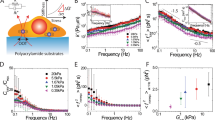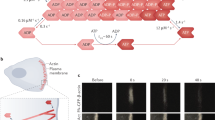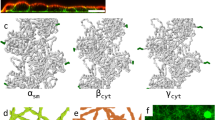Abstract
Material moduli of the cytoskeleton (CSK) influence a wide range of cell functions1,2,3. There is substantial evidence from reconstituted F-actin gels that a regime exists in which the moduli scale with frequency with a universal exponent of 3/4. Such behaviour is entropic in origin and is attributable to fluctuations in semiflexible polymers driven by thermal forces4,5,6,7, but it is not obvious a priori that such entropic effects are responsible for the elasticity of the CSK. Here we demonstrate the existence of such a regime in the living cell, but only at high frequencies. Fast events scaled with frequency in a manner comparable to semiflexible-polymer dynamics, but slow events scaled with a non-universal exponent that was systematically smaller than 3/4 and probably more consistent with a soft-glass regime8,9. These findings strongly suggest that at smaller timescales elasticity arises from entropic fluctuations of a semiflexible-filament network, whereas on longer timescales slow (soft-glass-like) dynamics of a different origin prevail. The transition between these two regimes occurred on timescales of the order of 0.01 s, thus setting within the slow glassy regime cellular events such as spreading, crawling, contracting, and invading.
This is a preview of subscription content, access via your institution
Access options
Subscribe to this journal
Receive 12 print issues and online access
$259.00 per year
only $21.58 per issue
Buy this article
- Purchase on Springer Link
- Instant access to full article PDF
Prices may be subject to local taxes which are calculated during checkout




Similar content being viewed by others
References
Chicurel, M. E., Chen, C. S. & Ingber, D. E. Cellular control lies in the balance of forces. Curr. Opin. Cell. Biol. 10, 232–239 (1998).
Discher, D. E., Janmey, P. & Wang, Y. L. Tissue cells feel and respond to the stiffness of their substrate. Science 310, 1139–1143 (2005).
Janmey, P. A. & Weitz, D. A. Dealing with mechanics: mechanisms of force transduction in cells. Trends Biochem. Sci. 29, 364–370 (2004).
Gittes, F., Schnurr, B., Olmsted, P. D., MacKintosh, F. C. & Schmidt, C. F. Microscopic viscoelasticity: Shear moduli of soft materials determined from thermal fluctuations. Phys. Rev. Lett. 79, 3286–3289 (1997).
Morse, D. C. Viscoelasticity of concentrated isotropic solutions of semiflexible polymers. 2. Linear response. Macromolecules 31, 7044–7067 (1998).
Gardel, M. L., Valentine, M. T., Crocker, J. C., Bausch, A. R. & Weitz, D. A. Microrheology of entangled F-actin solutions. Phys. Rev. Lett. 91, 158302 (2003).
Gardel, M. L. et al. Elastic behavior of cross-linked and bundled actin networks. Science 304, 1301–1305 (2004).
Fabry, B. et al. Scaling the microrheology of living cells. Phys. Rev. Lett. 87, 148102 (2001).
Bursac, P. et al. Cytoskeletal remodelling and slow dynamics in the living cell. Nature Mater. 4, 557–561 (2005).
Kas, J., Strey, H. & Sackmann, E. Direct imaging of reptation for semiflexible actin filaments. Nature 368, 226–229 (1994).
MacKintosh, F. C., Kas, J. & Janmey, P. A. Elasticity of semiflexible biopolymer networks. Phys. Rev. Lett. 75, 4425–4428 (1995).
Gittes, F. & MacKintosh, F. C. Dynamic shear modulus of a semiflexible polymer network. Phys. Rev. E 58, R1241–R1244 (1998).
Gisler, T. & Weitz, D. A. Scaling of the microrheology of semidilute F-actin solutions. Phys. Rev. Lett. 82, 1606–1609 (1999).
Gardel, M. L. et al. Scaling of F-actin network rheology to probe single filament elasticity and dynamics. Phys. Rev. Lett. 93, 188102 (2004).
Morse, D. C. Viscoelasticity of tightly entangled solutions of semiflexible polymers. Phys. Rev. E 58, R1237–R1240 (1998).
Morse, D. C. Viscoelasticity of concentrated isotropic solutions of semiflexible polymers. 1. Model and stress tensor. Macromolecules 31, 7030–7043 (1998).
Stamenovic, D., Suki, B., Fabry, B., Wang, N. & Fredberg, J. J. Rheology of airway smooth muscle cells is associated with cytoskeletal contractile stress. J. Appl. Physiol. 96, 1600–1605 (2004).
Alcaraz, J. et al. Microrheology of human lung epithelial cells measured by atomic force microscopy. Biophys. J. 84, 2071–2079 (2003).
Desprat, N., Richert, A., Simeon, J. & Asnacios, A. Creep function of a single living cell. Biophys. J. 88, 2224–2233 (2005).
Gardel, M. L. et al. Prestressed F-actin networks cross-linked by hinged filamins replicate mechanical properties of cells. Proc. Natl Acad. Sci. USA 103, 1762–1767 (2006).
Draeger, A., Stelzer, E., Herzog, M. & Small, J. Unique geometry of actin-membrane anchorage sites in avian gizzard smooth muscle cells. J. Cell Sci. 94, 703–711 (1989).
Bagby, R. M., Young, A. M., Dotson, R. S., Fisher, B. A. & McKinnon, K. Contraction of single smooth muscle cells from Bufo marinus stomach. Nature 234, 351–352 (1971).
DeFeo, T. T. & Morgan, K. G. Responses of enzymatically isolated mammalian vascular smooth muscle cells to pharmacological and electrical stimuli. Pflugers Arch. 404, 100–102 (1985).
Fabry, B. et al. Time scale and other invariants of integrative mechanical behavior in living cells. Phys. Rev. E 68, 041914 (2003).
Sollich, P., Lequeux, F., Hebraud, P. & Cates, M. E. Rheology of soft glassy materials. Phys. Rev. Lett. 78, 2020–2023 (1997).
Cates, M. E. & Sollich, P. in Foams and Emulsions (eds Sadoc, J. F. & Rivier, N.) 207–236 (Kluwer Academic, Dordrecht, 1999).
Mason, T. G., Gisler, T., Kroy, K., Frey, E. & Weitz, D. A. Rheology of F-actin solutions determined from thermally driven tracer motion. J. Rheol. 44, 917–928 (2000).
Gopal, A. D. & Durian, D. J. Relaxing in foam. Phys. Rev. Lett. 91, 188303 (2003).
Puig-de-Morales, M. et al. Cytoskeletal mechanics in adherent human airway smooth muscle cells: probe specificity and scaling of protein-protein dynamics. Am. J. Physiol. Cell Physiol. 287, C643–C654 (2004).
Wang, N. et al. Cell prestress. I. Stiffness and prestress are closely associated in adherent contractile cells. Am. J. Physiol. Cell Physiol. 282, C606–C616 (2002).
Bulatov, V. V. & Argon, A. S. A stochastic-model for continuum elastoplastic behavior. 2. A study of the glass-transition and structural relaxation. Modelling Simul. Mater. Sci. Eng. 2, 185–202 (1994).
Weeks, E. R., Crocker, J. C., Levitt, A. C., Schofield, A. & Weitz, D. A. Three-dimensional direct imaging of structural relaxation near the colloidal glass transition. Science 287, 627–631 (2000).
Mazurin, O. V. Theory of glass-transition—chemical-equilibria approach. J. Non-Cryst. Solids 129, 259–265 (1991).
Kovacs, A. J., Aklonis, J. J., Hutchinson, J. M. & Ramos, A. R. Isobaric volume and enthalpy recovery of glasses. 2. Transparent multi-parameter theory. J. Polym. Sci. Polym. Phys. 17, 1097–1162 (1979).
Chen, H. S. & Turnbull, D. Evidence of a glass–liquid transition in a gold–germanium–silicon alloy. J. Chem. Phys. 48, 2560–2571 (1968).
Sollich, P. Rheological constitutive equation for a model of soft glassy materials. Phys. Rev. E 58, 738–759 (1998).
Wang, N., Butler, J. P. & Ingber, D. E. Mechanotransduction across the cell surface and through the cytoskeleton. Science 260, 1124–1127 (1993).
Deng, L., Fairbank, N. J., Fabry, B., Smith, P. G. & Maksym, G. N. Localized mechanical stress induces time-dependent actin cytoskeletal remodeling and stiffening in cultured airway smooth muscle cells. Am. J. Physiol. Cell Physiol. 287, C440–C448 (2004).
Choquet, D., Felsenfeld, D. P. & Sheetz, M. P. Extracellular matrix rigidity causes strengthening of integrin-cytoskeleton linkages. Cell 88, 39–48 (1997).
Mijailovich, S. M., Kojic, M., Zivkovic, M., Fabry, B. & Fredberg, J. J. A finite element model of cell deformation during magnetic bead twisting. J. Appl. Physiol. 93, 1429–1436 (2002).
Acknowledgements
The authors would like to thank C. Gallant for her assistance in the adaptation of the cell isolation method. X.T. is supported by a postdoctoral fellowship from the Spanish Ministerio de Educación y Ciencia. This study was financially supported by NIH HL65960, HL33009 and HL31704.
Author information
Authors and Affiliations
Corresponding author
Ethics declarations
Competing interests
The authors declare no competing financial interests.
Supplementary information
Supplementary Information
Supplementary figures S1 and S2 (PDF 289 kb)
Rights and permissions
About this article
Cite this article
Deng, L., Trepat, X., Butler, J. et al. Fast and slow dynamics of the cytoskeleton. Nature Mater 5, 636–640 (2006). https://doi.org/10.1038/nmat1685
Received:
Accepted:
Published:
Issue Date:
DOI: https://doi.org/10.1038/nmat1685
This article is cited by
-
Monitoring the mass, eigenfrequency, and quality factor of mammalian cells
Nature Communications (2024)
-
A structure-based cellular model reveals power-law rheology and stiffening of living cells under shear stress
Acta Mechanica Sinica (2023)
-
Role of Conformational Entropy in Complex Macromolecular Systems
Chemical Research in Chinese Universities (2023)
-
Intracellular softening and increased viscoelastic fluidity during division
Nature Physics (2021)
-
Rheology of rounded mammalian cells over continuous high-frequencies
Nature Communications (2021)



